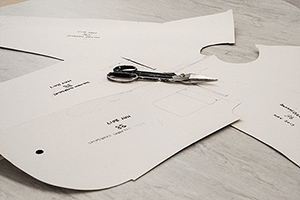Of middling quality
Wednesday, 2nd March 2016
Mankind has been placing one garment on top of another — starting with the one nearest the body, and working step-by-step outwards — since just after the concept of wearing clothes began. In recent years, this accretional method of dressing has been coined “layering” — and as everybody now knows, you can’t have layering without a “mid-layer”.
This month sees the arrival of two such mid-layers. The first is the work jacket. Now, like many mid-layers, the work jacket is a textbook “is it a this or is it a that?” sort of garment. Too heavy to be a shirt, in other words, and too light to be called a jacket. Well — almost. For it definitely is a jacket. But it is light. It is unstructured. The construction of its internal elements and its lining is very thin; there are as few layers of cloth as possible.

The collar of the work jacket is a “stand-up collar” style — known sometimes as a Mandarin or Nehru collar: named after the uniforms of bureaucrats in old China, or of noblemen in mid-20th century India, depending on your historical preference. It curves up around the neck, this version of the collar — coming up a little higher at the back — and is decorated with stitch-lines running its length. Large seam-to-seam pockets go across the front of the jacket — “stowaway pockets” as they were once called in this neck of the woods — and four others are dotted, inside and outside, about the chest. Can it be worn as a jacket? Indubitably yes. And as one of those fabled mid-layers? Yes, too.
Same goes for the new overshirt, very different in appearance though it is. The overshirt, see, is a notch or two towards “shirt” on the “is it a this or is it a that?” chart. You could never outright call it a jacket, by virtue of its outward appearance. It just wouldn’t wash. But, below the bonnet, it is very much built like a sturdy jacket or coat: a world away from a shirt, or most overshirts, or indeed many a jacket. It has a measly three pockets to the work jacket’s five, but what pockets they are: whopping great welts, with pocket-bags stitched through in thicker thread to break up the overshirt’s otherwise no-fuss fizzog.
Both garments are made with linen-cotton — or arguably cotton-linen, since both materials are in almost equal proportion — which is woven in the easternmost outskirts of Lancashire. It is a hopsack weave. The appearance of a basketweave, is what that means, with weft and warp running up and down and up and down over one another in a bold and uniform sort of manner. It is heavy cloth. But, since it is in large part linen, the thinking goes, airy and breathable, as well. And, if nothing else, the linen imbues what would otherwise be a straight-faced workwear-type cloth with haphazard slubbiness.
Regrettably, there is no mid-layer department here to speak of, so the work jacket is in with the jackets, and the overshirt, because it contains the word “shirt”, with the shirts.




